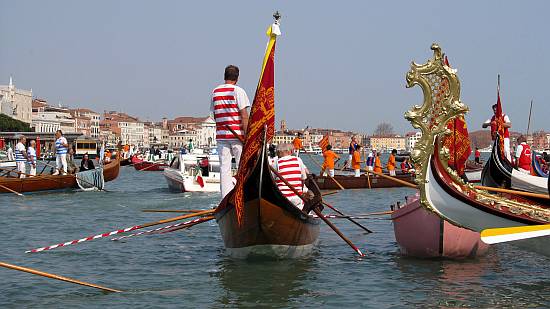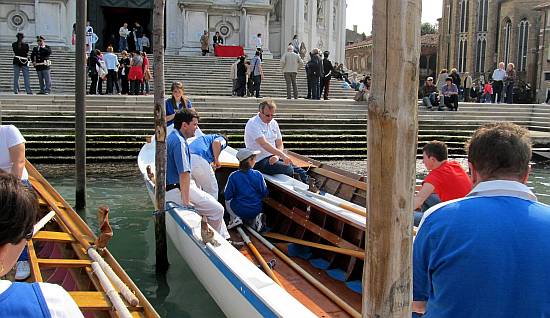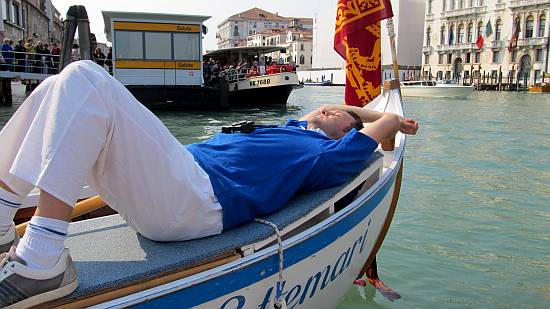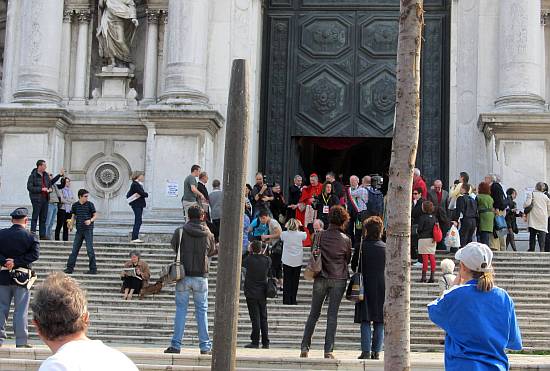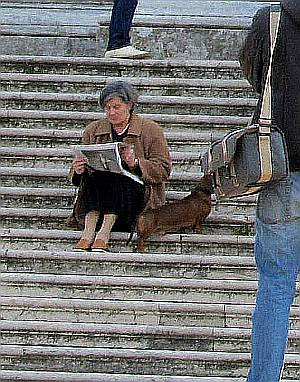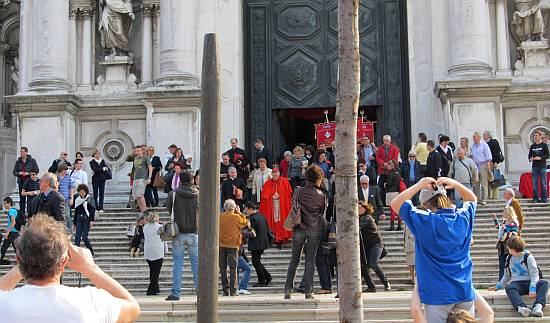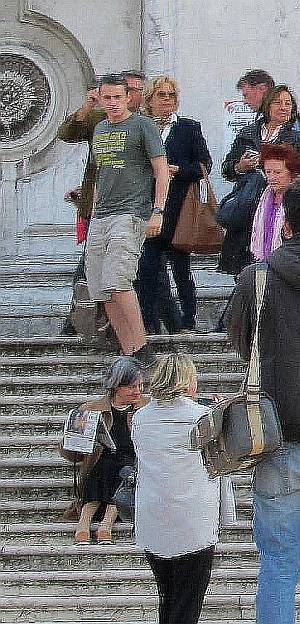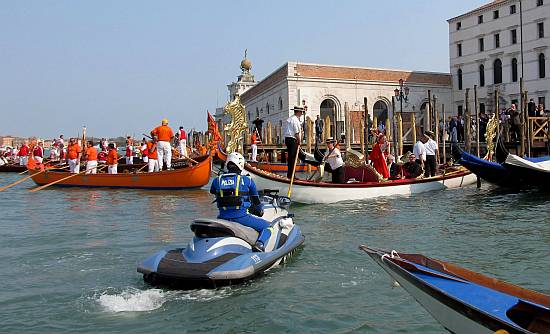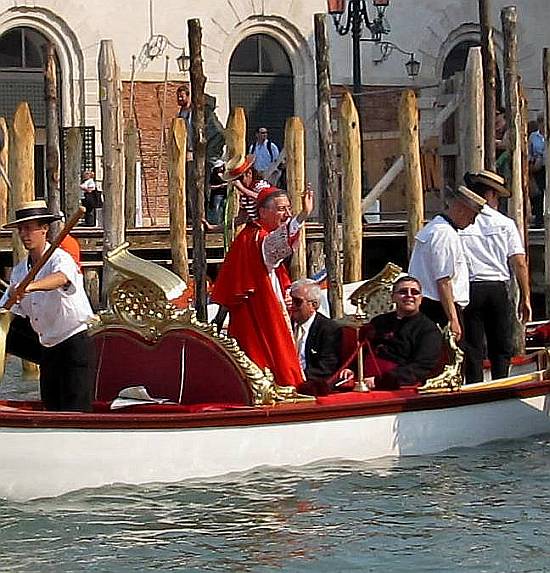Venice doesn’t have a bishop — you may be fascinated to know — it has a patriarch. And as of last Sunday, it has a new one: Francesco Moraglia, who has now been launched to a higher sphere from modest but reverendable monsignor to patriarch and, very soon, to cardinal. Next stop? We don’t speak its name, but we know it’s there.
Three patriarchs of Venice in the 20th century were elected pope (Pius X, John XXIII, and John Paul I). Which means that one reason — perhaps the main reason — why it took six months to decide on the new occupant of the patriarch’s palace could be that the man needed to be considered papabile, as they say: “pope-able.”
As you can imagine, his welcome ceremony was a many-splendored thing, but the centerpiece — and the piece feasible only in Venice — was a corteo, or procession, of boats in the Grand Canal.
Corteos, if you do them right (as in: have lots of participants), are impressive when seen from the shore/bridge/parapet/balcony or wherever the viewer may be positioned. Certainly they’re impressive as seen from the vessel carrying the person being corteo’d.
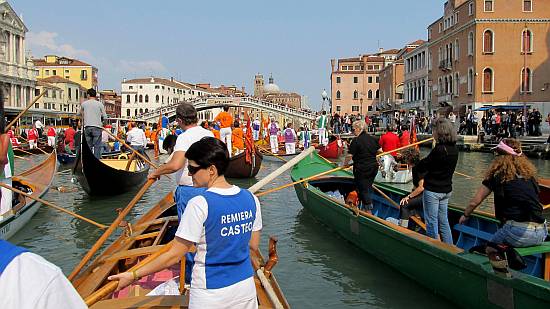
Corteos, as seen from the boats involved, have a much different character. They are composed of friends — or people who know each other, anyway — and what may look like a stately progress is actually a continual jockeying for position in a limited space complicated by vaporettos, gusts of wind, and tidal forces. All of these factors conduce to moments of vivacious confusion which most of the rowers astern, responsible for steering, know how to navigate. I can promise you, however, that there will be at least one boat whose poppiere has a very uncertain grasp of the connection between the action of the oar and the reaction of the boat. Fancy way of saying: helplessly wandering hither and yon like a rudderless boat on the high seas. This person, whoever it may be, is always happiest right in front of us.

The Gazzettino reported that there were some 200 boats in the procession, and I can believe it. I think most of them, though, were there for the event in its Venetian, rather than spiritual, aspect. I’m not saying rowers are godless, I’m just saying that the mass of participants seemed to be divided into two groups: Bunches of people along the fondamentas with welcome banners who were singing hymns , and us in the boats who were living another sort of moment.
The routine usually goes like this: The boats gather in the Grand Canal at Piazzale Roma. We go to the command-post boat if we’re due any bonuses (T-shirts, bandannas, small bags of rations usually containing a sandwich, bottle of water or carton of fruit juice, a small pastry or piece of fruit.) You lounge around and keep track of your friends. At this point in my evolution here, there’s quite a list.

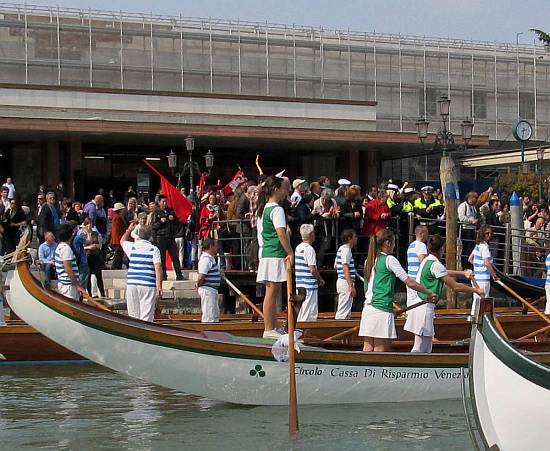
Small organizational point: Unlike most processions, which are in the morning, we were summoned to appear at 1:45 PM. This seemingly innocuous moment effectively wipes Sunday off your calendar, when you calculate the time needed to get to your boat, row it to Piazzale Roma, do the corteo, and row home. The fact that the timing effectively wiped your lunch hour off your calendar was also noticed. That’s why they gave us sandwiches. Not much to keep you going till dinnertime, but if you came, you’d already accepted this fact.
We get the signal to start, and we proceed down the canal to the bacino of San Marco, dodging taxis and vaporettos and gondoliers and each other’s oars. The principles of defensive driving all come into immediate play for the half-hour or so it usually takes to run this 3.7 km/2.3 mile route.
I’d never seen so many boats in a procession, not even when we put on the same event in 2002 for the recently-departed predecessor. The sun was shining, the breeze was generally docile, and we were going mostly with the tide.
The only drawback was the long wait for the patriarch to finish his invisible ceremonies ashore, board his boat, and get going. When the tide is pulling you along and large public conveyances keep jostling for space, you don’t really feel like hanging around, even for an Eminence. Rowers began to murmur and to comment.
But finally we were on our way. We managed to put on a burst of speed to get past the small boat slewing around in front of us. We waved to Lino’s sisters on the fondamenta. And when we passed under the Rialto Bridge and saw the straight stretch of Grand Canal covered with boats spread out before us, Lino actually got a little choked up. I can’t remember what he said, but I looked up and his eyes were wet. Just in case you think we get all blase and jaded about everything.
As the patriarch debarked at San Marco, the gathered boats gave the customary alzaremi, or raised-oar salute. It’s spectacular when done right, or even just sort of right. The annoying part for the executors of this feat isn’t the weight of the oar as you haul it upright (I discovered a trick) — it’s the way the water runs down the shaft and onto your hands. I have no picture of it because I was busy with my oar.
Then we row back to the club, across the bacino of San Marco, which will always be full of big heavy clashing waves. You may well also have the wind and tide against you, so by the time you get the boat ashore you’ve forgotten how much fun you had.

But enough about me. I can tell you that the new patriarch has already remarked that he believes one of our main priorities needs to be to make children happy. He put that in his short list of things we need to take more seriously, like create more jobs and be more just and fair in our dealings.
My inner Protestant (I.P.) finds this an amazingly dim recommendation. If making children happy is a goal, I can turn over and go back to sleep, because that must be the easiest thing on earth to do. Unload a dump truck full of sugar and fat and iEverything and then leave them alone. My I.P. — who is as devoted to children and their well-being as anyone, even him — would have preferred to hear something a little less fluffy. If happy children are what we want, I think our mission should be to make sure they’re educated, healthy, disciplined, kind, at least bilingual and don’t smoke. I suspect that happiness would be within their own grasp at that point, and wouldn’t have to be provided by a squad of round-the-clock muffinbrains.
Feel free to pass this observation along to him.
